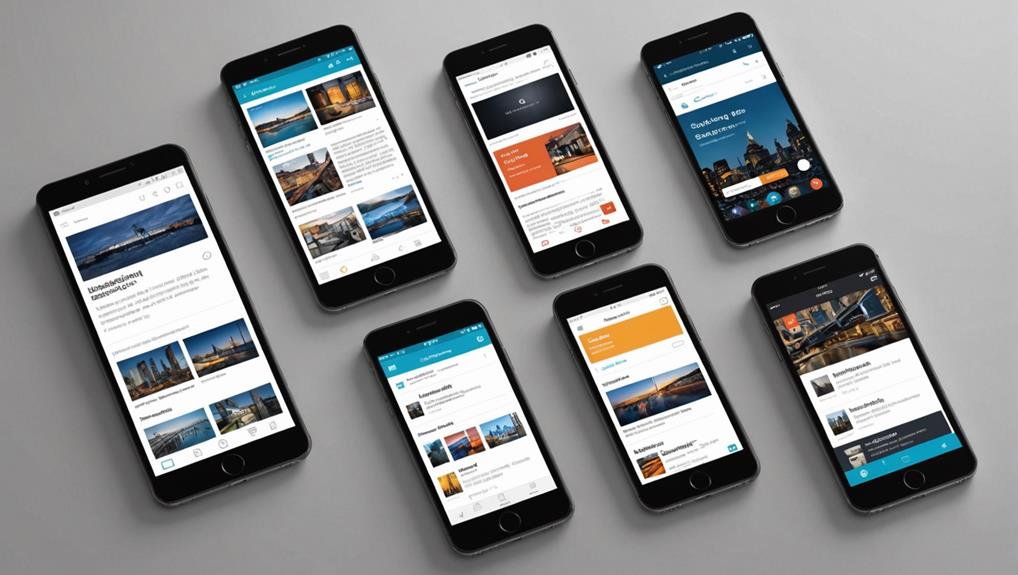In today’s digital age, every small and medium-sized business needs to make a great website to attract customers and build their brand. A great website isn’t just about looking good; it must also be practical, easy to use, and secure. While most business owners know the importance of SEO, user experience, and security, they may overlook other crucial elements like lead generation tactics, client feedback, and mobile-friendly design. All these parts work together to make a great website that stands out and serves its visitors well.
To truly make a great website, you must include 15 essential elements that help boost its effectiveness. These elements range from clear calls to action and fast-loading pages to easy navigation and engaging content. Incorporating these features will help you keep visitors on your site longer and turn them into loyal customers. Dive in with us as we explore these critical components and learn how to make them work for your business.
Crafting an Effective Website with LaunchedKey Takeaways
- A well-designed website features a visually appealing layout, straightforward navigation, and user-friendly features.
- SEO optimization is crucial to increase website visibility and improve search engine rankings.
- Strong security measures are essential to protect data and prevent cyber attacks.
- Effective lead generation strategies and CTA optimization can enhance conversion rates and customer engagement.
- Incorporating customer testimonials, tutorials, and learning resources can increase credibility and provide user assistance.
Engaging Design and Visual Appeal
A website’s visual charm is not just a matter of beauty; it’s a crucial component that directly impacts user involvement and brand recognition. The design of a website, shaped by color palettes, typefaces, and visual hierarchy, can either attract or deter visitors.
An engaging design starts with a careful selection of color palettes. Colors can evoke emotions and associations, creating a sense of familiarity and belonging. Consequently, a harmonious palette can improve user involvement and elevate brand recognition.
Typefaces, often overlooked, significantly contribute to a website’s visual appeal. The right fonts enhance readability while also adding to the overall visual appeal. They can subtly convey a brand’s personality, making the website more relatable and inviting.
A clear visual hierarchy, achieved through the strategic arrangement of elements, guides users smoothly through the website. It eliminates confusion, leading to a more pleasant browsing experience.
High-quality visuals and standout images can instantly capture users’ attention, powerfully conveying key messages. When aligned with the brand, these visuals create a cohesive and polished look, making the website memorable. Consequently, the fusion of these elements results in a visually attractive website that nurtures user involvement.
Defining Website Functionality and Purpose
Understanding a website’s functionality and purpose is the cornerstone of an effective online presence. A clear definition of your website’s purpose and objectives is the compass that directs your design decisions, content creation, and comprehensive digital strategy. This is not merely about aesthetics or appeal; it’s about creating an environment where your target audience feels a sense of belonging and finds value.
Identifying your target audience and understanding their needs is crucial. It helps you develop a website that caters to user needs and expectations, fostering a sense of inclusivity and community. Your website should serve as a bridge connecting your business goals with the needs of your users, providing a platform where both can benefit.
Content organization is another critical aspect that influences user experience. Presenting content logically and user-friendly improves the overall user experience and invites users to engage with your site more deeply. A user-friendly navigation menu is essential in this regard, as it allows easy access to information, enhancing user engagement and satisfaction. Let your website be a guiding light, illuminating how users find what they need and feel a sense of belonging.
Importance of SEO Optimization

Embracing the power of SEO Optimization in the online domain can significantly improve a website’s performance and reach. It is an effective tool that enhances website visibility, increases search engine rankings, and drives natural traffic. Using keyword optimization strategies ensures that your content aligns with what your audience is searching for, increasing user engagement.
Quality backlinks prove your website’s authority, indicating its credibility to search engines. They are the foundation of Google’s authentic PageRank algorithm and contribute significantly to your website’s visibility.
Implementing structured data improves your website’s visibility in search results by providing search engines with additional information about your website’s content. This increases the likelihood of achieving rich results, which can enhance click-through rates.
Technical SEO aspects are equally significant. They are essential in website indexing and performance, ensuring search engines can crawl and index your website without issues.
| SEO Optimization | Impact on Website | Importance |
|---|---|---|
| Keyword Optimization | Increases natural traffic and engagement | Aligns with user searches |
| Quality Backlinks | Establishes website authority | Indicates credibility to search engines |
| Technical SEO Aspects | Improves website indexing and performance | Ensures smooth crawl and indexing by search engines |
Enhancing User Experience
Two key points emerge as we focus on improving user experience with a user-centric design approach and integrating interactive elements. The user-centric design approach is not just a buzzphrase; it underlines the effectiveness of a website design that resonates with the target audience and caters to their needs and preferences. Meanwhile, interactive elements in a website design can significantly boost user engagement, making the website an active rather than passive user experience.
User-Centric Design Approach
A user-focused design approach is central to creating an exceptional website. This method prioritizes users’ needs and preferences to guarantee a smooth browsing experience. Its focus on intuitive navigation eases users’ passage through the website. Clear calls to action are strategically placed to enrich user engagement and guide them toward desired actions.
- Efficient Content Organization: Content is arranged logically and effectively, improving readability and comprehension. This results in user-friendly interfaces that boost overall user satisfaction.
- User Behavior Analysis: In-depth understanding of user behavior and preferences enables customized website design development. Such designs resonate more with users, leading to higher engagement rates.
- Mobile Responsiveness: In our mobile-first world, a website’s accessibility and adaptability on mobile devices are fundamental features. This ensures a positive user experience across various devices, expanding the website’s reach.
- User-focused Design: Crafting a website with the user at the core of the design process nurtures a sense of belonging and inclusivity, making the website a preferred resource for its audience.
These components collectively enrich the user experience, making the website a pleasure to engage with.
Interactive Elements Integration
Integrating interactive components into a website is crucial to achieving an outstanding user experience. These components serve as magnets that draw users, hold their attention, and foster an environment of engagement. With interactive features like quizzes and surveys, it’s no surprise that user engagement can surge by 80%.
This integration is not just about engagement; it’s a strategic tool to reduce bounce rates. The longer a user lingers, captivated by interactive maps or calculators, the lower the bounce rate and the higher the time spent on the site.
Furthermore, interactive components can directly impact customer satisfaction. Consider integrating live chat support, which provides immediate assistance and contributes to a positive user experience. This interactive element can significantly improve customer satisfaction and, in turn, increase conversion rates.
The bottom line is that integrating interactive components enriches the user experience and distinguishes your website. It creates a memorable user voyage, contributing significantly to user satisfaction and fostering a sense of belonging.
Maintaining Website Performance

While many factors contribute to a website’s success, maintaining peak performance is crucial. This requires a keen focus on several key components to guarantee users are attracted to your site and stay engaged.
- Website Performance: Superior website performance is a cornerstone of a successful site. It reduces bounce rates and promotes higher user engagement. A smoothly operating website welcomes users, fostering a sense of belonging.
- Fast Loading Speed: Speed is of the essence in the digital realm. Fast loading speed is crucial in retaining visitors and improving SEO rankings. The faster the site, the quicker users can access the content they seek.
- Analytics: Regularly tracking site engagement through analytics is an indispensable practice. It provides insights into user behavior and preferences, enabling website owners to make informed decisions for improving site performance.
- Mobile Responsiveness: In an increasingly mobile world, ensuring your website is responsive on all devices enriches accessibility and user experience. It allows users to engage with your site conveniently, promoting overall site engagement.
Implementing Security Measures
Implementing robust security measures is vital in website creation. Integrating components such as SSL certificates, a fundamental tool in data protection, is essential for securing user transactions and preserving sensitive information. Concurrently, the regular execution of security scans and the steadfast prevention of cyber-attacks are substantial pillars in fortifying a website’s safety wall.
Preventing Cyber Attacks
Given the rising threat of cyber attacks, it’s essential to implement robust security measures for your website. This ensures data integrity and fosters a sense of belonging among your users, assuring them that their information is secure and valued.
- One of the primary steps toward preventing cyber-attacks is validating an SSL certificate. An SSL certificate is critical for data encryption and maintaining a secure connection between web servers and browsers. It shields your website’s data from unauthorized access and tampering.
- Another significant measure is keeping your website’s software and extensions updated. Updates often include patches for vulnerabilities that cybercriminals could otherwise exploit.
- Solid and distinctive passwords are your website’s first line of defense. Password managers can help generate and store such passwords securely, greatly enhancing your website’s security.
- Finally, adhering to security protocols is essential. This includes regular audits, employee training, and developing a thorough incident response plan.
Regular Security Scans
Proactively safeguard your website from potential threats, routine security scans emerge as an essential tool in your cybersecurity arsenal. These scans, performed consistently, serve as vigilant gatekeepers, detecting vulnerabilities that could attract unwelcome cyber attacks.
Crafted with precision, security scans meticulously comb through your website’s structure, identifying and suppressing malware before it can cause harm. This systematic approach to cybersecurity guarantees that threats lurking in the shadows are brought into the light and neutralized promptly.
Sensitive data, the lifeblood of an online presence, is effectively shielded with these regular scans. By maintaining the integrity and confidentiality of this data, you create an online sanctuary where users can interact freely, knowing their information is secure. This sense of security fosters a sense of belonging among your audience, enhancing their engagement with your website.
Moreover, by identifying potential risks, these scans prompt timely software updates, reinforcing your website’s defenses and keeping it ahead of possible breaches. Hence, routine security scans form a robust layer of protection, fortifying your website against the constantly changing landscape of cyber threats.
SSL Certificate Importance
An SSL certificate ensures secure transactions and bolsters your website’s defenses. This online certificate is a crucial tool for data encryption, offering a secure connection between a user’s browser and the website server. It’s a necessary component in the architecture of a great website, providing a shield against lurking cyber-attacks.
- Data encryption: SSL certificates encrypt sensitive information, such as credit card numbers and passwords, making them unreadable to anyone except the server to which you send the information. This prevents hackers from stealing your information.
- SEO improvement: An SSL certificate is a critical factor in Google’s algorithm, with HTTPS websites enjoying a push in search rankings.
- Trust and confidence: The padlock icon in the address bar, indicative of an SSL certificate, builds trust with users. They feel more secure sharing personal information on such websites.
- Guard against cyber-attacks: SSL certificates effectively deter cyber-attacks, significantly reducing the chances of data breaches.
In a digital realm rife with threats, SSL certificates offer a sanctuary of security, instilling a sense of belonging and safety among users.
Ensuring Content Quality and Relevance

Engaging and relevant content is the lifeblood of any successful website, serving as a magnet that attracts and retains visitors. Fine-tuning the content quality, incorporating stellar copywriting techniques, and aligning the material with user needs is essential to ensuring user satisfaction and engagement.
A clear value proposition is paramount. It elucidates your website’s benefits, communicating the unique value that users can derive. Furthermore, regularly updating content keeps the website fresh, reinforcing its relevance to visitors.
Here’s a breakdown of the critical components:
| Component | Description |
|---|---|
| Content Quality | High-quality, well-researched content enhances user experience. |
| User Engagement | Effective copywriting techniques improve readability and engagement |
| Relevance | Content should align with user interests to maximize visitor satisfaction |
| Value Proposition | Communicate the benefits of your website |
| Regular Updates | Keep content fresh and relevant to maintain visitor engagement |
Remember, the content you provide is not just information; it’s an experience, an invitation to a community where users feel a sense of belonging. Make it count.
[NEXT SUBTOPIC]:
Effective Call-to-Action Implementation
Effective Call-to-Action Implementation
Implementing compelling call-to-action (CTA) elements is vital to developing a successful website. Crafting compelling CTAs and optimizing their visibility can significantly influence user engagement and conversion rates. In the upcoming discussion, we’ll delve into the art of creating CTAs that grab attention and the science of strategically placing them for maximum visibility and interaction.
Crafting Compelling CTAs
Crafting compelling CTAs is crucial in website development in terms of user engagement and conversion rates. CTAs, or Call-to-Actions, are strategic prompts that guide users towards desired actions, turning passive website visitors into active participants.
Crafting effective CTAs isn’t merely about telling visitors what to do; it’s about convincing them that taking the action would be advantageous. The more specific and enticing the benefits, the more likely users are to engage.
Here are four key elements to consider when crafting compelling CTAs:
- Clarity: CTAs should be clear, concise, and direct, providing users with a precise understanding of what action they’re expected to take.
- Benefits: Highlight the advantages that the user will receive by taking action. These could range from gaining access to valuable information to a discount on a product or service.
- Engagement: The language used in CTAs should evoke a sense of belonging, making users feel part of a larger community or cause.
- Placement: While we’ll explore CTA placements further in the next section, strategic placement can significantly influence user action and conversion rates.
Optimizing CTA Visibility
While the art of crafting compelling CTAs is indeed significant, understanding how to optimize their visibility is equally vital for a website’s success. By improving their visibility, CTAs can boost website conversion rates significantly. Bright and contrasting colors, for example, can enhance CTA visibility, making them more attractive and likely to capture users’ attention.
Great CTAs must have a clear and benefit-driven message. Users are more likely to engage with CTAs that offer clear benefits and are specific to their needs. Hence, the message should be brief, concise, and impactful to prompt quick decisions.
The placement of CTAs is another crucial aspect of effectiveness. Well-placed CTAs guide users toward desired actions, providing a sense of direction and purpose. These strategic placements create a sense of belonging for users, enriching their experience and engagement with the website.
| CTA Characteristics | Significance | Implementation |
|---|---|---|
| Bright, Contrasting Colors | Grabs attention | Use colors that stand out but also align with the website’s color scheme |
| Clear, Benefit-Driven Message | Prompts user action | Craft concise and compelling messages that clearly state the benefit |
| Short and Concise | Facilitates quick decisions | Avoid jargon and keep the CTA message short and to the point |
| Well-Placed | Guides user action | Place CTAs strategically throughout the site to guide users |
| Increases Conversion Rates | Enriches website success | Regularly test and tweak CTA elements to maximize effectiveness |
User-Friendly Feature Integration

A website can be seamlessly integrated with many features to enhance its user-friendliness. By incorporating breadcrumbs and search functionality, you can significantly improve user navigation and experience. Clear headers and straightforward inquiry processes also contribute to a more user-friendly experience, allowing users to quickly understand the website’s content and interact with it more effectively.
- Breadcrumbs and search functionality: These features guide users through your site, allowing for easy navigation and a more intuitive experience. Breadcrumbs show users their navigation path, while the search function provides direct access to specific content.
- Clear headers: This feature organizes your content, making it simple for users to find what they want.
- Straightforward inquiry processes: By simplifying these processes, you decrease the chance of users abandoning their inquiry due to complexity or confusion.
- Prominent call-to-action buttons and personalized content: These features improve user engagement. Call-to-action buttons guide users towards desired actions, while tailored content creates a sense of belonging, making users feel valued and understood.
Effective Lead Generation Strategies
Through careful planning and insightful understanding of user requirements, a potential 68% enhancement in lead quality can be achieved. Effective lead generation is more than a numbers game; it is a finely tuned symphony of tailored engagement and focused marketing that aims to comprehend and fulfill user needs.
Segmenting leads can increase conversions by 72%. This approach is similar to hosting a cozy gathering rather than a bustling party. The emphasis is on the individual, their distinct interests, and how your service can fulfill their requirements.
Tailoring in lead generation strategies is the secret ingredient to increase engagement by 56%. It’s about creating an atmosphere of belonging, where each lead is not just a number but a valued community member.
Focused marketing, driven by comprehensive lead data, can skyrocket conversion rates by 49%. This tactic values and recognizes the uniqueness of each lead, contributing to a 10% increase in sales revenue. Therefore, establishing an effective lead generation strategy is advantageous and crucial for a successful website.
Incorporating Customer Testimonials and Feedback

The power of customer testimonials and feedback cannot be underestimated when building a great website. These elements bring genuineness and credibility to your site and greatly influence purchasing decisions, improving conversion rates. This section will methodically detail how to effectively showcase user experiences and encourage constructive criticism to enhance your website’s reputation and performance.
Showcasing User Experiences
While many may underestimate its importance, showcasing user experiences – mainly through client testimonials and feedback – is a cornerstone of an effective website strategy. This builds trust, credibility, and a sense of belonging among potential customers, ultimately aimed at increasing conversions and revenue.
- Client Testimonials: Incorporate these as they are proven to increase conversions by up to 270%. They provide real-world validation of your product offerings, enhancing your credibility.
- Online Reviews: An impressive 90% of consumers read online reviews before purchasing. Make sure to display these prominently, as they are as influential as personalized recommendations.
- Building Trust and Credibility: Showcasing user experiences demonstrates transparency and honesty, which can help build trust with your audience.
- Revenue Increase: A website displaying client testimonials can see a revenue increase of 62%. This is a clear indication of the power of user experiences in driving sales and growth.
Encouraging Constructive Criticism
Nurturing an environment that promotes constructive feedback is essential for building on the power of user experiences. This enhances website credibility and fosters trust, creating a feeling of belonging for your audience. Incorporating customer testimonials and online reviews can increase conversions dramatically, significantly impacting user perception and decision-making.
An insightful website owner recognizes the importance of online reviews, as an astounding 90% of consumers rely on them before making a purchase decision. Trust is a fragile and valuable asset, with an impressive 85% of consumers placing as much faith in online reviews as they would in personal endorsements.
Constructive feedback presents a golden opportunity to showcase dedication to customer satisfaction and continuous improvement. Transparently showcasing positive and negative feedback enhances your website’s genuineness. It demonstrates your readiness to evolve and adjust based on customer needs and preferences.
Providing Tutorials and Learning Resources
Guidance through tutorials and educational materials is crucial to a website’s success. They act as a connection, linking users with the website’s tools and features, effectively improving the user experience.
- Tutorials: Step-by-step guides demonstrate how to use website tools and enable users to discover and utilize the site’s full potential. Tutorials are an excellent tool for user retention as they ensure users can easily navigate the website.
- Learning Materials: These provide detailed information about the website’s features. They enhance user engagement and satisfaction by addressing queries and offering troubleshooting tips and techniques.
- User Experience: Tutorials and learning materials greatly enrich the user experience. They give users the confidence to interact efficiently with website tools and features.
- Informative content refers to content that informs users about the site’s capabilities. It could be in the form of blogs, infographics, or videos.
Implementing tutorials and learning resources fosters a sense of belonging for the users, making them feel valued and essential to the website’s community.
Implementing Online Business Strategies

In website management, implementing online business methods is a pivotal step toward securing a broader audience reach and enhancing revenue streams. By leveraging these methods, businesses can seamlessly attract users and generate leads by creating a sense of belonging. The key is creating an environment conducive to customer engagement and fostering an online community where each user feels valued.
One proven strategy is using QR codes for donations, which promotes user engagement. This approach gives users a sense of participation and contribution, enhancing their connection with the business. Analogously, starting an online coaching or tutoring business can be a lucrative strategy. It creates a revenue stream and establishes a platform for knowledge sharing, nurturing a community of learners.
Effective implementation of these methods, however, requires meticulous planning and execution. The ultimate goal is revenue generation and creating a distinct user experience that encourages repeat visits and customer loyalty. By focusing on these aspects, businesses can optimize their online presence and achieve growth and success in the digital arena.
Importance of Good Website Design
Why is a good website design necessary for businesses? A good website design is the cornerstone of establishing an online presence and credibility. It attracts website visitors and keeps them engaged, fostering a sense of belonging.
- Enhanced User Experience: Good website design ensures an intuitive and user-friendly interface. It allows users to navigate easily, find information quickly, and interact efficiently, creating a positive user experience.
- Improved SEO Rankings: A quality web design is vital for search engine optimization. It makes your website more visible on search engines, attracting more visitors and potential customers.
- Effective Digital Marketing: Digital marketing strategies are more successful when implemented on a well-designed website. A good design amplifies the impact of these strategies, enhancing the website’s performance.
- Increased Credibility: A professionally designed website exudes trust and credibility, which is essential for any business aiming to establish a solid online presence.
Adapting Mobile-Friendly Design

The shift towards digitization has made mobile-friendly design more than a convenience – it’s now a necessity. With 61% of users favoring websites optimized for mobile devices, mobile optimization is no longer a luxury but a requirement. The implications of this are profound. A well-optimized mobile website improves user experience and influences your visibility on Google, prioritizing mobile functionality in its search rankings.
Responsive design plays a key role here, ensuring your website maintains its integrity across diverse devices and screen sizes. This adaptability eliminates the need for separate mobile apps, effectively streamlining the user experience and saving resources.
Moreover, embracing a mobile-first approach can significantly improve user engagement and satisfaction. This strategy involves designing mobile device websites and scaling to larger screens. It’s about making your audience feel valued and included, adapting to their needs, and creating a sense of belonging.
Frequently Asked Questions
What Makes a Good Website?
A good website combines clear purpose, easy navigation, mobile responsiveness, fast load speeds, engaging visuals, quality content, consistent branding, robust security, effective SEO, and clear CTAs, among other vital elements, to provide a superior user experience.
How can I make a great website for my small business?
To make a great website, start with a clean, professional design that reflects your brand and appeals to your target audience. Ensure the site is easy to navigate, with clear menus and links that guide visitors to important information. Mobile responsiveness is key, as many users browse on their phones. Include strong calls to action encouraging visitors to take the next step, such as signing up for a newsletter or purchasing. Don’t forget to add client testimonials and feedback, which build trust and showcase your value.
What Are 5 Important Things You Should Know When Building a Website?
A successful website prioritizes a clear purpose, understanding of the target audience, user-friendly navigation, responsive design, and optimized load time. These elements contribute to a user-oriented experience, fostering a sense of belonging among visitors.
How Can I Make My Website Awesome?
To improve your website, prioritize high-quality visuals, responsive design, fast loading speeds, clear calls-to-action, and robust security measures. These elements significantly contribute to user experience, engagement, and trust.
What Is the Most Important Thing for a Website?
The most crucial aspect of a website is its apparent purpose, tailored to the needs of its target audience. This clarity guides the design and content, fostering user engagement, enhancing user experience, and increasing conversion rates.
Conclusion
The effectiveness of a website is a fusion of different elements, including design, functionality, SEO, user experience, performance, tutorials, online strategies, and mobile adaptability. A surprising statistic reveals that 38% of people will stop engaging with a website if the layout is unattractive, underscoring the importance of visual appeal. Consequently, a balanced integration of all these factors is crucial for a website to stand out, enhancing its credibility, visibility, and user engagement.

Erik Remmel is a co-founder of Launched, a platform that helps businesses grow through AI-powered marketing, automation, and lead generation. He focuses on building scalable systems that convert cold leads into customers while streamlining operations with smart, AI-driven workflows.

